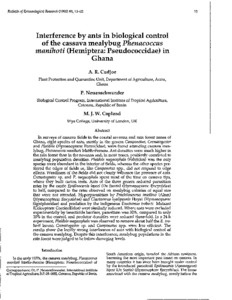| dc.contributor.author | Cudjoe, A. |
| dc.contributor.author | Neuenschwander, P. |
| dc.contributor.author | Copland, M. |
| dc.date.accessioned | 2019-12-04T11:27:49Z |
| dc.date.available | 2019-12-04T11:27:49Z |
| dc.date.issued | 1993 |
| dc.identifier.citation | Cudjoe, A., Neuenschwander, P. & Copland, M. (1993). Interference by ants in biological control of the cassava mealybug Phenacoccus manihoti (Hemiptera: Pseudococcidae) in Ghana. Bulletin of Entomological Research, 83(1), 15-22. |
| dc.identifier.issn | 0007-4853 |
| dc.identifier.uri | https://hdl.handle.net/20.500.12478/5019 |
| dc.description.abstract | In surveys of cassava fields in the coastal savanna and rain forest zones of Ghana, eight species of ants, mostly in the genera Camponotus, Crematogaster and Pheidole (Hymenoptera: Formicidae), were found attending cassava mealybug, Phenacoccus manihoti Matile-Ferrero. Ant densities were much higher in the rain forest than in the savanna and, in most zones, positively correlated to mealybug population densities. Pheidole megacephala (Fabricius) was the only species more abundant in the interior of fields, whereas the other species preferred the edges of fields or, like Camponotus spp., did not respond to edge effects. Weediness of the fields did not clearly influence the presence of ants. Crematogaster sp. and P. megacephala spent most of the time on cassava tips, where they built carton tents. Ants of the three genera reduced parasitism rates by the exotic Epidinocarsis lopezi (De Santis) (Hymenoptera: Encyrtidae) to half, compared to the rates observed on mealybug colonies of equal size that were not attended. Hyperparasitism by Prochiloneurus insolitus (Alam) (Hymenoptera: Encyrtidae) and Chartocerus hyalipennis Hayat (Hymenoptera: Signiphoridae) and predation by the indigenous Exochomus troberti Mulsant (Coleoptera: Coccinellidae) were similarly reduced. Where ants were excluded experimentally by insectcide barriers, parasitism was 32%, compared to only 10% in the control, and predator densities were reduced three-fold. In a 24 h experiment, Pheidole megacephala was observed to remove about half the E. troberti larvae; Crematogaster sp. and Camponotus spp. were less efficient. The results show the locally strong interference of ants with biological control of the cassava mealybug. Despite this interference, mealybug populations in the rain forest were judged to be below damaging levels. |
| dc.language.iso | en |
| dc.subject | Mealybugs |
| dc.subject | Cassava |
| dc.subject | Parasitoids |
| dc.subject | Predators |
| dc.subject | Biological Control |
| dc.title | Interference by ants in biological control of the cassava mealybug Phenacoccus manihoti (Hemiptera: Pseudococcidae) in Ghana |
| dc.type | Journal Article |
| dc.description.version | Peer Review |
| cg.contributor.affiliation | Ministry of Food and Agriculture, Accra |
| cg.contributor.affiliation | International Institute of Tropical Agriculture |
| cg.contributor.affiliation | University of London |
| cg.coverage.region | Africa |
| cg.coverage.region | Acp |
| cg.coverage.region | West Africa |
| cg.coverage.region | Europe |
| cg.coverage.country | Ghana |
| cg.coverage.country | Benin |
| cg.coverage.country | United Kingdom |
| cg.authorship.types | CGIAR and developing country institute |
| cg.iitasubject | Pests Of Plants |
| cg.iitasubject | Plant Diseases |
| cg.iitasubject | Cassava |
| cg.iitasubject | Disease Control |
| cg.accessibilitystatus | Limited Access |
| local.dspaceid | 102282 |
| cg.identifier.doi | https://doi.org/10.1017/S0007485300041730 |

